Subscribe to Our Newsletter
Exceptional Creative
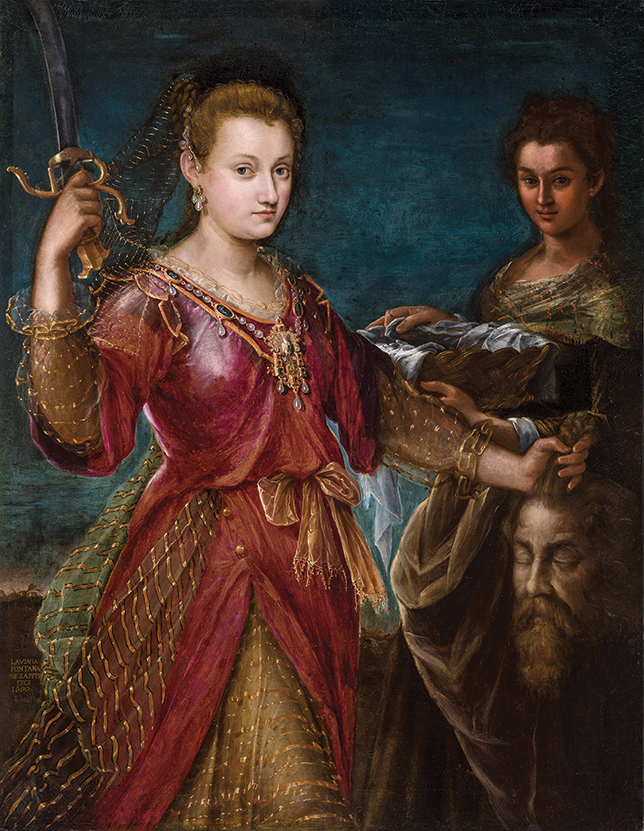
Lavinia Fontana, a Bolognese painter of the Cinquecento, broke barriers for women artists all while demonstrating extraordinary talent
by Ashley Busby
An exhibition at the National Gallery of Ireland, “Lavinia Fontana: Trailblazer, Rule Breaker” (on view through August 27th), highlights the groundbreaking achievements of a lesser-known, late Cinquecento painter from Bologna. To be certain, Fontana was an exception to the socio-political position afforded to women at the time. The word “exception” has both negative and positive connotations. Read as “exception,” the artist is in contrast to the rule—a woman working beyond the restrictions of her sex. Read as “exceptional,” we associate the talent with being unusual or rare—a comment upon skill. Lavinia Fontana was no mere “exception”; she was an “exceptional” artist. As NGI curator Aoife Brady argues, she was not simply an artist “prevailing” beyond her sex but rather one of “prodigious skill in painting” that begs (re)consideration.
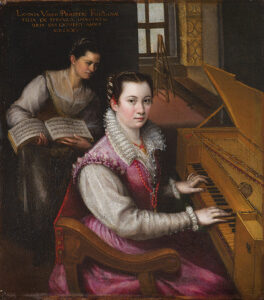
Lavinia Fontana, Self-Portrait at the Virginal, 1577, oil on canvas, (unframed) 27 x 23.8 cm, (framed) 47 x 44.5 x 6 cm.
Accademia Nazionale di San Luca, Roma. Photo: Mauro Coen.
Much of the previous scholarship on Fontana has focused on her biography, understanding her work as an achievement that resulted from her specific circumstances. Born in 1552 in Bologna, she was the daughter of Prospero Fontana (1512-1597), who was known for large scale fresco commissions and a series of portraits of Pope Julius III from the 1550s. (Prospero Fontana, a contemporary of Giorgio Vasari, also opened his own school, training several major Bolognese painters including Ludovico and Agostino Carracci.) Her mother, née Antonia de Bonardis, had connections to the city’s printing industry, and her family ran one of the largest publishing houses in Bologna. In short, Lavinia Fontana’s upbringing provided clear connections to the city’s intelligentsia and the art world.
Scholars note that Prospero Fontana may have never intended for his daughter to become one of the first professional female artists in Bologna. The earliest dated work by Lavinia Fontana was completed at age 23—relatively old for a professional artist. Still, she would have been provided with basic training in art as a teenager. Training in in the so-called “courtly arts” of music, drawing, painting, and writing was seen as a positive attribute, making a young woman more attractive to potential suitors.
The artist’s Self-Portrait at the Virginal (1577) serves as a record of this early training. Seated at center before a virginal or spinet, the subject (the artist) has fingers raised and flexed as though dancing across the keys; however, she sits in three-quarter view and stares directly at the viewer. Such visual engagement with the viewer suggests not only that she is skilled enough to play without looking but also that she is aware that she is the subject to be gazed upon. Her dress matches such expectations. Indeed, the artist presents herself not in ordinary daywear but rather in impressive finery. Her gown’s soft red color is complemented by pearl and lacework along with an intricate ruff. Golden ribbons wind through her braided up-do, and two beaded coral necklaces finish her styling. Nearby, a woman stands holding an open volume of sheet music. The inclusion of the text further stresses the artist’s musical skill, and the large bound format may also reference her family’s work in publishing. Along the back wall, a doorway provides a glimpse into a studio area with an easel, a reference to Lavinia Fontana’s artistic training. The portrait format at the virginal is also a likely reference to an earlier self-portrait (Self-Portrait at the Spinet, painted in 1561) by another accomplished woman painter of 16th-century Italy, Sofonisba Anguissola, who served as a portraitist in the court of Phillip II of Spain (1559-1573).
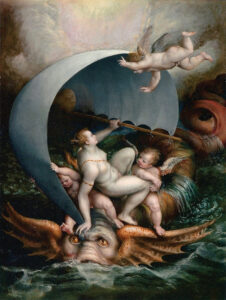
Lavinia Fontana, Galatea and Cherubs Riding the Stormy Waves on a Sea Monster, c. 1590, oil on copper, (unframed) 48 x 36.5 cm, (framed) 61 x 72.5 cm.
Private Collection
Lavinia Fontana’s skill as a painter, and especially her affinity for careful detail, is evident in this early self-portrait. This proficiency likely convinced Prospero Fontana to extend his daughter’s training. Unfortunately, around 1568, he encountered financial difficulties and, in his mid-fifties, struggled to keep pace with demand for his work. Providing young Lavinia with further training was likely a financial decision; he had no sons, and she showed evidence of the necessary talent to serve as an aid in his workshop.
In 1577, Fontana negotiated special conditions for his daughter’s marriage to Gian Paolo Zappi that allowed her to pursue a professional career. According to the marriage agreement, Zappi received no dowry and would move to the Fontana home where his teenage wife, Lavinia, already had access to a studio. (The earlier mentioned self-portrait, painted in 1577, was a gift for Zappi’s father prior to the marriage.) The elder Zappi, like Prospero Fontana, recognized his future daughter-in-law’s potential, allowing the marriage to proceed without a dowry—based on the new bride’s earning capacity.
Despite the arranged nature of their union, Lavinia and Gian Paolo Zappi appear to have enjoyed a great partnership. While she painted, he spent most of his time caring for and educating the couple’s 11 children (only four of whom survived to adolescence). Having had her first child in 1578, she would spend much of the next 18 years—and a large part of her professional career—pregnant. Her husband’s willingness to serve as caregiver surely made her professional career easier to navigate. Zappi also served as business manager, navigating economic contracts not entrusted to women during the era.
Lavinia Fontana’s location in Bologna also certainly contributed to her ability to embark upon a career as an artist. The city’s patron saint of artists, Catherine of Bologna (1413-1463), was a nun, author, and manuscript illuminator. Her cult was officially recognized by Pope Clement VII in 1524, confirming a supportive cultural context for female artistic expression. Bologna was also an anomaly in terms of access to education for women. The city’s university, the oldest in Europe, saw admittance for female students as early as the 13th century. While women remained barred from membership in Bologna’s guild system, by the end of the 18th century, the city had produced some 68 known female artists. Fontana’s successes almost certainly paved the way for these later generations of women artists in the city.
Much of Fontana’s commissioned work was in portraiture. Her family’s publishing connections served as a means to earn commissions in academic portraiture, including Portrait of Carlo Sigonio (c. 1578). In the painting, Fontana depicts the historian surrounded by items indicative of his profession—a desk laden with manuscripts and students gathered outside his doorway. He glares at the viewer, an inquisitive but authoritative look upon his face, and his right hand gestures to invite discourse. The artist also masterfully captures texture and detail. Sigonio wears a rich damask vesto with long fur lapels. The sitter’s coarse graying beard stands in stark textural contrast to his starched collar.
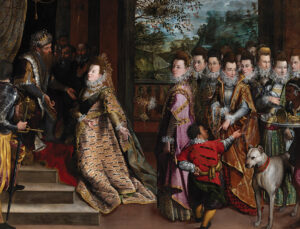
Lavinia Fontana, The Visit of the Queen of Sheba to King Solomon, 1599, oil on canvas, (un-framed) 251.7 x 326.5 cm, (framed) 284.5 x 358.7 x 12 cm.
Image, National Gallery of Ireland.
Unlike other major Italian cities during the era, Bologna was not dominated by a single major patron family such as the Medici clan in Florence. As a result, Fontana had access to a diverse patron base. In the 1580s, Bologna also saw relaxed sumptuary laws, which prescribed codes of dress, display, and consumption. This meant that jewels and elaborate fashions were now legally and socially acceptable. Silk production was also the single largest economic driver in the city. Thus, the display of such wares served as evidence of the sitter’s contributions to the local economy—and Fontana specialized in portraits that featured ostentatious displays of costume and ornament. Fortunately, clients deeply trusted the artist, and many of them allowed her to take their jewels back to the studio in order to best capture on canvas the particulars of fine workmanship. This mastery of detail (especially as it applies to the subject’s attire) is well demonstrated in the artist’s Portrait of Costanza Alidosi (c. 1595). The wife of a local senator, Alidosi’s elaborate finery stands as a demonstration of her family’s social position. Her black velvet overgown opens to reveal a damask underskirt. Gold fastenings, meticulous embroidery, and sumptuous jewels (a beaded headpiece, three rings, two strands of pearls, and ruby drop-earrings) are all rendered with startling accuracy. Resting in the sitter’s lap is a tiny spaniel—a symbol of wealth and fidelity, as well as a reference to Bologna’s breeding industry.
While Fontana excelled in portraiture, she also tackled other subject matter, including themes both biblical and mythic. Her Assumption of the Virgin with Saints Peter Chrysologus and Cassian (1584) was the artist’s first documented public commission, making her the earliest female artist to complete large-scale work of the type. The intricate embroidery, painted scenes, and rich silks of the saints’ robes demonstrate the same extraordinary ability seen in her portraits.
The artist also created inventive takes on then-popular biblical stories and motifs, including her Judith with the Head of Holofernes (1600), one of three works picturing the female hero from the Old Testament Apocrypha. Here, Fontana’s Judith is modelled as a self-portrait, much like the more well-known paintings of Judith by Artemisia Gentileschi. Fontana’s Judith is poised and triumphant. She confidently grips a scimitar—held aloft in her right hand—while clutching the head of her slain foe in her left. The artist contrasts the violence of the beheading with the beauty of the subject’s gown and jewelled accessories.
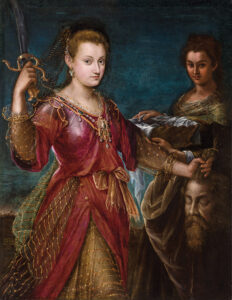
Lavinia Fontana, Judith with the Head of Holofernes, 1600, oil on canvas, (unframed) 123 x 97 cm, (framed) 171 x 142 x 25 cm.
Image: Museo Davia Bargellini, Bologna, Italy.
Historians also note that Fontana was the first woman painter to address the female nude. Her Venus and Mars (c. 1595) is a novel take on the amorous affair of these two celebrated figures from antiquity. Mars stares intently at his lover, one hand firmly grasping her buttocks. Venus twists to stare at the viewer, seemingly acknowledging their erotic behavior and further heightening the titillation of her nude form and their post-coital surroundings.
Perhaps the most impressive painting in the National Gallery’s exhibition is Fontana’s The Visit of the Queen of Sheba to King Solomon (1599), which has undergone recent conservation. The work is one of Fontana’s largest (251.7 x 326.5 cm) and provides ample space for the artist to lavish attention upon the costume of the gathered figures, including the over-the-top styling of Sheba’s female retinue—personages who take up almost half of the available space of the composition. Their dresses are a swirl of intricate embroidery, filigree lacework, dazzling jewels, and candy-colored silks. The titular meeting of the Old Testament royals appears at left, and curators provide a new possible reading for the work as portraits of the Duke and Duchess of Ferrara. Countering earlier accepted identifications for the figures, the exhibition substantiates such a reading in comparison portraits and other historical source materials. The work also provides evidence of Fontana’s skill and achievement as an artist, her mastery of multiple painting genres, her inventive compositions that link past subjects with the conditions of Cinquecento Italy, her impressive work as a colorist, and her extraordinary attention to detail in the rendering of costume, texture, and ornament.
Lavinia Fontana built an enviable career in Bologna working for the city’s elite. She excelled as a portraitist but also made other major artistic contributions. After her father died, Fontana and her family moved to Rome in 1603 at the behest of Pope Clement VIII; she served as a portraitist at the Vatican until her death in 1612. Her career and successes were, not unlike other women artists of the era, viewed as an exception to her sex, to the expectations of society, and to the (masculine) definition of the artist. Still, Fontana and her work exhibit tendencies that far exceed her classification as a mere anomaly. She was truly exceptional, highly skilled, and an exemplary trailblazer for the women artists who followed in her footsteps.




























